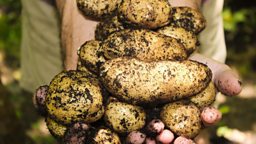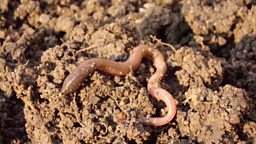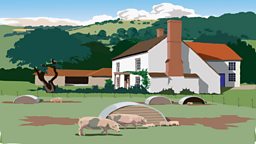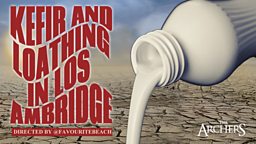Pants, pH and planning for the future of farming
The Archers’ new Farming & Countryside Advisor, looks at how a seemingly comic storyline has a serious underlying message about the soil on our farms.
Bury Your Y Fronts!
I live in north Cotswolds farming country, not far from Ambridge. Walking through our town, Archers fans keep asking me about pants, knickers and underwear! ‘Do you want to bury these?’ a farmer shouts slapping his bottom. While digging my allotment, a fellow veg grower asks: ‘Burying your smalls, are you?’
The Ambridge ‘Soiled Pants’ competition began one morning over a bowl of porridge. I was scrolling through Twitter and spotted a fun post from . He’s the farm manager at Overbury Estate, a 3,500 acre no-till arable and sheep farm in Worcestershire. He’d posted a photo of a pair of men’s pants that he was burying in a field. He tweeted, "If you know, you know." I did know and thought it would make a great storyline for the farmers of Ambridge.
Jake is a pioneering farmer. He’s on a mission to educate us about soil and is passionate about sharing his work on the farm. He explained that burying a pair of cotton pants eight inches deep for a few weeks could reveal a great deal about the health of the soil. He said, "The more holes they have and the more ragged your buried pants are, the better the soil. Lots of holes mean the bacteria, fungi and worms are doing their thing, as the organisms munch through the cotton."
I’ll admit, there were moments when my imagination got carried away with storyline suggestions... Tony loses his favourite Y-fronts…Lilian gets the wrong end of the stick and plants something saucy and frilly… Jim buries his pants and then can’t find them for show day … You get the picture! But thankfully, our brilliant team of producers and writers created the perfect drama based around the Ambridge Flower and Produce Show.
Teeming with life
At this point, it’s worth talking about the importance of our soil. The brown stuff is the farmer’s most treasured asset – it’s where everything is planted and it’s where the grass grows for livestock. If a farmer has good soil, they’ll have better yields, healthy stock and probably a decent bank balance. Our soil is also important for resilience against changing weather patterns, because as well as growing our food, the soil soaks up carbon dioxide from the atmosphere.
Soil may look brown and inert, but our soil is alive. It’s teeming with life. Worms, beetles and centipedes are easy to spot but if you look at a handful of soil through a magnifying glass, you’ll see a world every bit as fascinating as the life we see in a Sir David Attenborough documentary on the African plains or frozen Antarctic. The earth’s soil is home to billions of creatures, bacteria, fungi and micro-organisms. It’s packed with nematodes, springtails, minerals, carbon, gas, water and air. All life depends on this humble layer of brown dirt.

The successful farmers of the future will be the ones who care for their soil. For British famers, cash subsidies are changing, and payments will be linked to environmental care for the land. It’s why you may have noticed that ‘regenerative farming’ is growing in popularity and getting more coverage in the media. It’s farming with the land, nature and the environment. Farmers use fewer chemicals and caring for the soil underpins the regenerative way of farming.
'A.R.S.E'
This summer, was at The Archers’ farming desk and dug deeper into our soil story. Anna decided to put the Ambridge soil under the microscope: the earth at all the Ambridge farms – ���˿��� Farm, Grange Farm and Brookfield, along with the rewilding project. She created the cheeky acronym A.R.S.E (Yes, I know!) – the Ambridge Rural Soil Enterprise.
The project recognises that farmers are working hard to understand their over-worked soil. But Anna faced a tricky problem. She said, "For a programme maker, soil is a challenging topic to bring to life. It doesn't make any cool noises, it isn't cute and talking about soil can get boring very quickly.
"We had to find a way of highlighting arguably the most important issue on earth while making it accessible, interesting and entertaining too. Burying underpants and a bit of friendly competition always helps."
Anna worked with Dr Elizabeth Stockdale, Head of Farming Systems Research at NIAB (National Institute of Agricultural Botany) and Dr Anne Bhogal, Soil Scientist at ADAS (Agriculture Development Advisory Service) who helped us imagine what a Soil Health Scorecard for the Ambridge farms and rewilding might be like.
This is a tool for farms to ‘benchmark’ their soil. It’s a sort of Strictly Come Dancing style scoring system for soil – except rather than measuring the Cha Cha Cha, we’re marking the soil’s structure, organic matter, nutrients, worms and pH (acidity or alkalinity).

Benchmarking and sharing soil information is relatively new. In the past, farmers may have kept their soil secrets close to their chests, but the exchange of knowledge is bringing farmers together. Anna said, "Farming can be stressful and lonely and anything that can help farmers work together has social benefits as well as environmental ones. Benchmarking soil is a great way of bringing neighbours together, as well as gathering valuable data."
From ‘Soiled Pants’ to their ‘A.R.S.E’ scorecards, our Ambridge farmers care about their soil. Next time you’re in the garden, digging the allotment or out in a green space, take a look at that dirty, brown treasure beneath your feet – you may be surprised at what you find.
















































